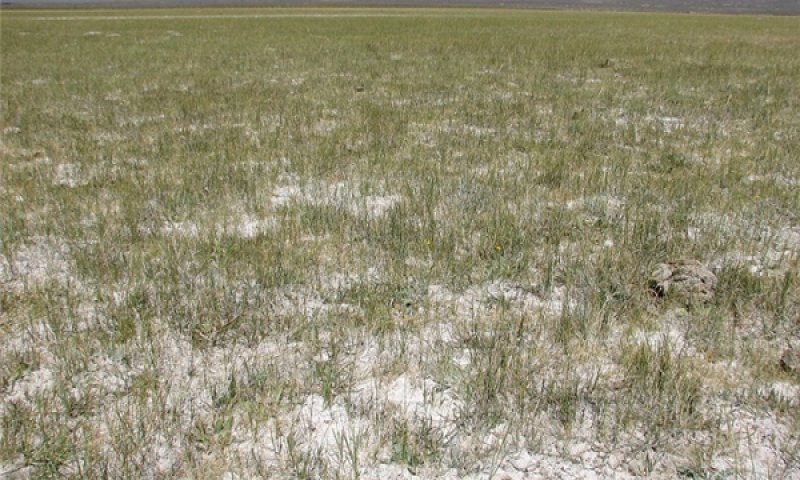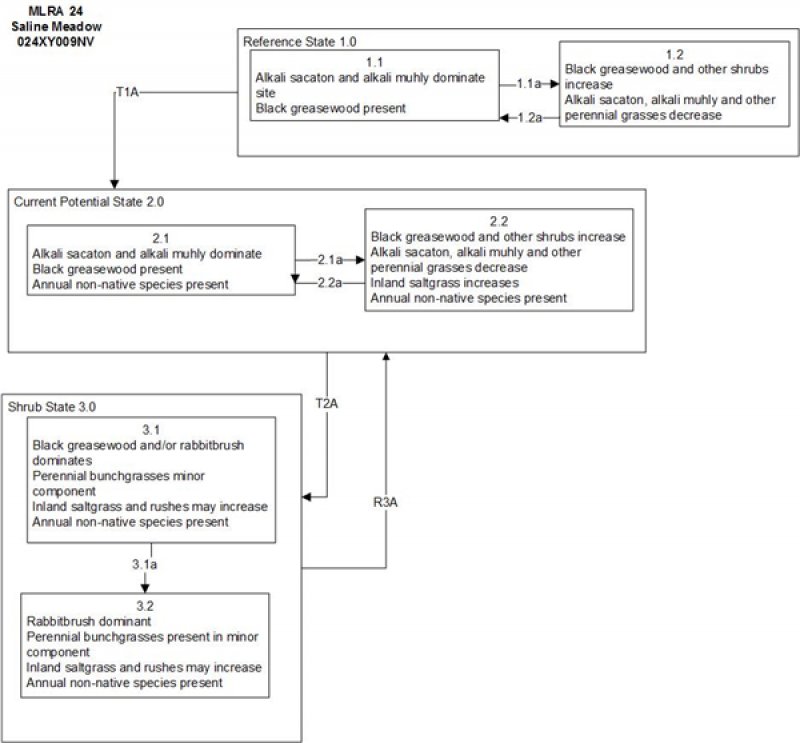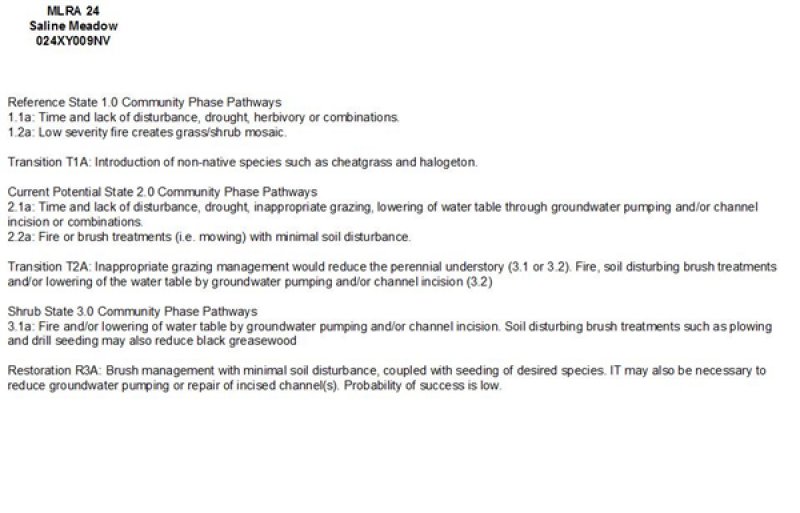Ecological dynamics
An ecological site is the product of all the environmental factors responsible for its development and it has a set of key characteristics that influence a site’s resilience to disturbance and resistance to invasives. Key characteristics include 1) climate (precipitation, temperature), 2) topography (aspect, slope, elevation, and landform), 3) hydrology (infiltration, runoff), 4) soils (depth, texture, structure, organic matter), 5) plant communities (functional groups, productivity), and 6) natural disturbance regime (fire, herbivory, etc.) (Caudle et al 2013). Biotic factors that influence resilience include site productivity, species composition and structure, and population regulation and regeneration (Chambers et al. 2013).
The Great Basin shrub communities have high spatial and temporal variability in precipitation, both among years and within growing seasons. Nutrient availability is typically low but increases with elevation and closely follows moisture availability. The moisture resource supporting the greatest amount of plant growth is usually the water stored in the soil profile during the winter. The invasibility of plant communities is often linked to resource availability. Disturbance can decrease resource uptake due to damage or mortality of the native species and depressed competition or can increase resource pools by the decomposition of dead plant material following disturbance.
Drought will initially cause a decline in bunchgrasses, but prolonged drought will eventually cause a decline in shrubs, including black greasewood. As site condition deteriorates, this site may become dominated by rabbitbrush and black greasewood. Marcum and Kopec (1997) found inland saltgrass more tolerant of increased levels of salinity than alkali sacaton therefore dewatering and/or long term drought causing increased levels of salinity would create environmental conditions more favorable to inland saltgrass over alkali sacaton. Alkali sacaton is considered a facultative wet species in this region; therefore it is not drought tolerant. A lowering of the water table can occur with ground water pumping in these sites. This may contribute to the loss of deep rooted species such as greasewood and basin wildrye and an increase in rabbitbrush, shadscale and other species with the absence of drought.
Basin wildrye is a large, cool-season perennial bunchgrass with an extensive deep coarse fibrous root system (Reynolds and Fraley 1989). Clumps may reach up to six feet in height (Ogle et al 2012b). Basin wildrye does not tolerate long periods of inundation; it prefers cycles of wet winters and dry summers and is most commonly found in deep soils with high water holding capacities or seasonally high water tables (Ogle et al 2012b, Perryman and Skinner 2007). The sensitivity of basin wildrye seedling establishment to reduced soil water availability is increased as soil pH increases (Stuart et al. 1971). Lowering of the water table through extended drought, channel incision or water pumping will decrease basin wildrye production and establishment, while sagebrush, black greasewood, rabbitbrush, and invasive weeds increase. Farming and abandonment may facilitate the creation of surface vesicular crust, increased surface ponding, and decreased infiltration; which leads to dominance by sprouting shrubs and an annual understory.
This ecological site has moderate resilience to disturbance and resistance to invasion. Primary disturbances include drought, fire, flooding, and channel incision or other disturbance leading to a lowered seasonal water table. This facilitates an increase in shrubs and a decrease in perennial grasses. The introduction of annual weedy species, like cheatgrass (Bromus tectorum), may cause an increase in fire frequency and eventually lead to an annual state or a state dominated by rabbitbrush. Other troublesome non-native weeds such as broadleaved pepperweed or tall whitetop (Lepidium latifolium), hoary cress or whitetop (Cardaria draba), scotch cottonthistle (Onopordum acanthium) or bull thistle (Cirsium vulgare) are potential invaders on this site. Two possible alternative stable states have been identified.
As ecological condition declines and where management results in abusive grazing use by livestock or feral horses, woody plants often increase, especially rabbitbrush species. Inland saltgrass and Baltic rush increase and become the main understory species. Fivehook bassia, annual mustards, foxtail barley and other annual forbs and grasses are species likely to invade this site.
Fire Ecology:
There is very little fire frequency information available for saline meadow communities prior to presettlement times. It is estimated that fire may have occurred every 7 to 10 years. Alkali sacaton is classified as tolerant of, but not resistant to, fire. Top-killing by fire is frequent, and the plants can be killed by severe fire. Saltgrass rhizomes occur deep in the soil where they are insulated from the heat of most fires. Saltgrass survives fire by sending up new growth from rhizomes. Alkali cordgrass has high fire tolerance. Basin wildrye is top-killed by fire. Older basin wildrye plants with large proportions of dead material within the perennial crown can be expected to show higher mortality due to fire than younger plants having little debris. Basin wildrye is generally tolerant of fire but may be damaged by early season fire combined with dry soil conditions.
Community 1.1
Alkali sacaton/alkali muhly

Figure 5. Saline Meadow
The plant community is dominated by alkali sacaton with lesser but significant amounts of alkali muhly, bluegrass, inland saltgrass and alkali cordgrass.
Potential vegetative composition is about 90 percent grasses, 5 percent forbs and 5 percent shrubs.
Approximate ground cover (basal and crown) is 50 to 85 percent.
Table 5. Annual production by plant type
| Plant type |
Low
(lb/acre) |
Representative value
(lb/acre) |
High
(lb/acre) |
| Grass/Grasslike |
490 |
700 |
1050 |
| Shrub/Vine |
175 |
250 |
375 |
| Forb |
35 |
50 |
75 |
| Total |
700 |
1000 |
1500 |
Community 1.2
Black greasewood/Alkali sacaton
Black greasewood and other shrubs increase in the absence of disturbance. Decadent shrubs dominate the overstory and deep-rooted perennial bunchgrasses in the understory are reduced either from competition with shrubs, herbivory, drought or combinations of these.
Pathway 1.1a
Community 1.1 to 1.2
Absence of disturbance over time, significant herbivory, long term drought or combinations of these would allow the black greasewood overstory to dominate the site and reduce the perennial bunchgrasses. Inland saltgrass may increase in the understory depending on the timing and intensity of herbivory. Heavy spring utilization will favor an increase in black greasewood.
Pathway 1.2a
Community 1.2 to 1.1
Low severity fire creates a grass/shrub mosaic.
State 2
Current Potential State
This state is similar to the Reference State 1.0 with two similar community phases. Ecological function has not changed, however the resiliency of the state has been reduced by the presence of invasive weeds. Non-natives may increase in abundance but will not become dominant within this State. These non-natives can be highly flammable and can promote fire where historically fire had been infrequent. Negative feedbacks enhance ecosystem resilience and contribute to the stability of the state. These feedbacks include the presence of all structural and functional groups, low fine fuel loads, and retention of organic matter and nutrients. Positive feedbacks decrease ecosystem resilience and stability of the state. These include the non-natives’ high seed output, persistent seed bank, rapid growth rate, ability to cross pollinate, and adaptations for seed dispersal.
Community 2.1
Alkali sacaton/greasewood
This community is dominated by alkali sacaton and black greasewood. Alkali muhly and rabbitbrush are also common on these sites. Inland saltgrass, alkaligrass and other perennial bunchgrasses and shrubs make up smaller components. Non-native annual species such as halogeton and cheatgrass are present.
Community 2.2
Black greasewood/perennial bunchgrasses
Black greasewood and big sagebrush increase in the absence of disturbance. Decadent shrubs dominate the overstory and deep-rooted perennial bunchgrasses in the understory are reduced either from competition with shrubs, inappropriate grazing management, drought or combinations of these.
Pathway 2.1a
Community 2.1 to 2.2
Time and lack of disturbance, drought, inappropriate grazing, lowering of water table through groundwater pumping and/or channel incision or combinations of these.
Pathway 2.2a
Community 2.2 to 2.1
Fire or brush treatments with minimal soil disturbance.
State 3
Shrub State
This state has two community phases, one that is characterized by a co-dominance of black greasewood and rabbitbrush and the other with rabbitbrush overstory. This site has crossed a biotic threshold and site processes are being controlled by shrubs. Bare ground has increased.
Community 3.1
Black greasewood
Decadent black greasewood dominates the site. Perennial bunchgrasses are present but a minor component. Annual non-native species may be present and may be increasing in the understory.
Community 3.2
Rabbitbrush
Rabbitbrush dominates the overstory. Deep-rooted perennial bunchgrasses may be present in trace amounts or absent from the community. Annual non-native species increase. Bare ground is significant.
Pathway 3.1a
Community 3.1 to 3.2
Fire and/or lowering of water table by groundwater pumping and/or channel incision. Soil disturbing brush treatments such as plowing and drill seeding may also reduce black greasewood.
Transition T1A
State 1 to 2
Introduction of non-native species such as cheatgrass and halogeton.
Transition T2A
State 2 to 3
Inappropriate grazing management would reduce the perennial understory and/or lowering of the water table by groundwater pumping and/or channel incision.
Restoration pathway R3A
State 3 to 2
Brush management with minimal soil disturbance, couple with seeing of desired species . It may also be necessary to reduce groundwater pumping or repair incised channel(s). Probability of success is low.




